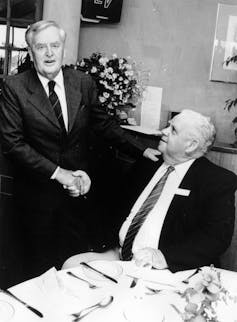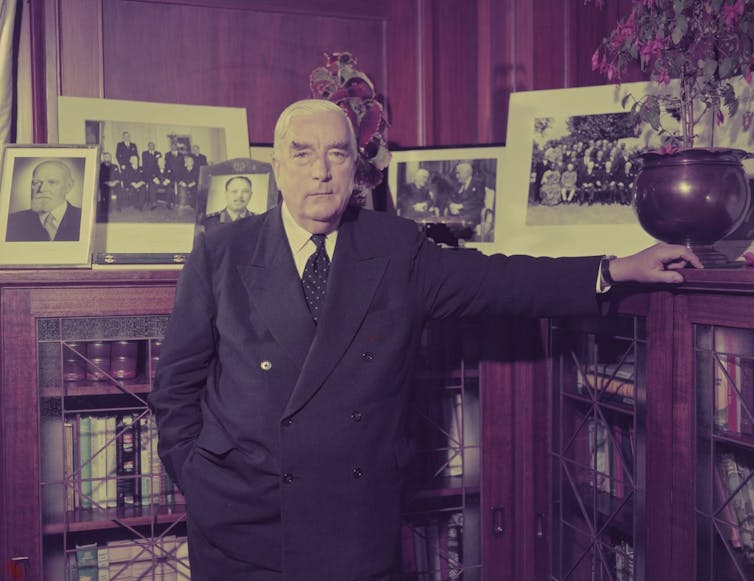Political parties are integral to the Australian political system, yet also largely absent from the Commonwealth Constitution itself. They are not entirely absent: a constitutional amendment in 1977 – secured, as required by law, through a referendum – ensured that a casual vacancy for the Senate would be filled by a member of the same party. But until then, in a system dominated by parties and especially by the competition of two major parties – Labor and Liberal – the document formally establishing Australia’s federal political system was silent about them.
At the time of federation in 1901, political parties had already become established in Australia. Political historian Sean Scalmer has argued that the National Reform and Protection League (NRPL), founded in Victoria in 1877 and led by Graham Berry, was Australia’s first mass political party.
Read more: How Graham Berry brought party democracy to colonial Australia – and then was forgotten
Supported by large numbers of urban workers, manufacturers, shopkeepers and farmers, it favoured tariff protection (a tax on imports to help develop local industry), land taxation to break up the big estates in favour of smallholders, and a curb on the powers of the undemocratically elected upper house, the Legislative Council.
Victoria’s polarised politics was one of the factors that led to party formation. Parties developed more slowly elsewhere: New South Wales acquired its first at the 1887 election – Free Trade and Protectionist parties – and South Australia not until the following decade. Queensland had political groups with some of the features of modern political parties by the 1880s; these were based on particular regional and economic interests. Groupings remained more fluid and informal in Tasmania and Western Australia – the latter not a self-governing colony until 1890.
Labor and Liberal parties find a foothold
It is therefore wrong to imagine there were no political parties before the emergence of a Labor party in four of the six colonies in the early 1890s. Labor was formed by unions and retained a formal place for them in its organisation. It also developed local leagues or branches, as they became more commonly known. Labor joined a political system in which parties were already becoming familiar, but outside Victoria had not been around long enough to draw voters into an intimate relationship.
Labor represented itself as the voice of the working class, but also often made a wider claim to represent “the people” or “the masses”. It exploded onto the political scene in NSW at the 1891 election, with 35 seats in a Legislative Assembly of 141.
Labor parties emerged more slowly elsewhere, but the party evolved a strong party discipline reflected in the pledge members signed to follow the party platform, retire from an election if not endorsed, and vote as a majority of the parliamentary party – called the caucus – decided.
The Labor parties in the colonies were able to form a loosely organised national party with a federal platform in time for the first federal election in 1901. It became one of three parties in the federal parliament, the others being Free Trade Liberals led by George Reid, and Liberal Protectionists – led by Edmund Barton and, from 1903, Alfred Deakin, the political star of the era and prime minister three times.
In 1909, there was a “fusion” of the Liberal parties. This meant that in 1910, for the first time, the choice voters faced was between Labor and Liberal. Labor – now with a wide base of working-class support supplemented by farmers, small business interests, a growing number of Catholics and some middle-class people – won majorities in both houses of parliament at that election. It seemed to have the country at its feet. The party’s split in the first world war over conscription became the first of three such fractures over the next 40 years. As a result, Labor has governed for about a third of the time since 1910, the non-Labor parties for about two-thirds.
By the time of the 1919 election, Australia once again seemed to have veered into a three-party arrangement with the emergence of a Country Party. It was formed by organisations representing farmers and graziers, but pitched its appeal to a wider group of country-minded voters who lived in towns but who saw their own interests as bound up with the fate of those on the land. One of the key impulses was to bring to the bush the kinds of advantages, such as reliable electricity, good roads and educational opportunity, more available in the large cities.
The origins of the Liberal-National coalition
After the 1922 election, the Country Party formed a coalition with the main non-Labor party, by this time called the Nationalists. That bond has endured at the national level, with just occasional breaks, through to today, giving Australia what some have called a two-and-a-half party system.
The relationship was not universally successful. In Victoria, the Country Party often remained independent of the major non-Labor party and sometimes cooperated with Labor. In Queensland, the Country Party – later called the Nationals – was the senior coalition partner in governments extending from 1957 to 1983.
Under premier Joh Bjelke-Petersen (1968–87), the Nationals went it alone for several years, causing much harm to his federal Liberal colleagues along the way. In 2008, the two parties reckoned with that history by amalgamating to form the Liberal National Party (LNP) in Queensland. In Canberra, some LNP members sit in the Liberal party room, and some in the Nationals party room, only coming together when the Coalition meets as a whole.

The Australian Labor Party has had a continuous existence since Federation, and the Country/National Party since the end of the first world war. It has been a different story for the major non-Labor party.
Called “Fusion” or “Liberal” from 1909, it became the Nationalists in 1917 and the United Australia Party in 1931. It then reverted to being the Liberal Party in 1944 (although with some variations, for a time, at the state level) – the name it has retained to this day.
Robert Menzies, Australia’s longest-serving prime minister, played a major role in the formation of the modern Liberal Party, although it is inaccurate to call him its founder, as is commonly claimed. The name “Liberal” was deliberately chosen to give the party a modern and progressive tone. This is because earlier parties of the centre-right, such as the Nationalists and the United Australia Party, had become financially dependent on wealthy business interests to an extent that had undermined their claims to represent “the community” or “the middle class”.
Menzies had famously sought to define the natural constituency of such a party in a 1942 radio broadcast with the title “The Forgotten People”. By this he meant people who were represented neither by trade unions nor big business, but were the hardworking and self-sacrificing people in between.

As the country changes, so do the parties
As Australia’s economy, society and culture changed, so did the nature of the party system, but the major parties, at least at first, proved very adaptable. The Liberals under Menzies recognised, in the wake of two world wars and the Depression, that the bulk of voters were no longer prepared to equate freedom and justice with mainly unfettered markets. They embraced more interventionist government and an expanded welfare state, while keeping a wary eye on any tendency towards policy that smacked of socialism. They were rewarded by voters with 23 years in office at the national level between 1949 and 1972.
Labor remained wedded to a larger role for the state in modifying market outcomes and promoting economic development and social welfare. Several state Labor government pursued such policies. Labor did better in the states than nationally, governing NSW between 1941 and 1965, Queensland from 1932 to 1957, Tasmania from 1934 to 1969, and WA for substantial periods. Only in SA and Victoria did Labor do poorly.
Both independents and minor parties had long been a feature of Australia’s politics, but none managed to break a system that still offered only the prospect of being governed by one or the other side at each national election. The Communist Party of Australia was formed in 1920 and was affiliated with the Third International, based in the Soviet capital Moscow. It ran candidates at elections, with just one victory, of lawyer Fred Paterson, in the Queensland state seat of Bowen in 1944, but by the end of the war its national membership was about 22,000.
Out of the Labor Party split of 1955 there emerged the Democratic Labor Party (DLP), which was strongest in Victoria. The DLP was aggressively anti-communist and dominated by Catholics; it directed preferences to the Liberal Party and won Senate seats.
From the 1960s, small parties emerged to represent progressive voters who felt alienated from the Labor, Liberal and Country parties, each of which was identified with established social classes, economic interests and political ideologies. One example was the Australia Party, which was a forerunner of the more successful Australian Democrats, a party led initially by former Liberal minister Don Chipp. It came to exercise significant influence in the federal Senate through its balance of power in the 1980s and ‘90s.
By the mid-1960s, the major political parties and their leaders were being increasingly attacked by media commentators as backward-looking and out of touch with modern Australia. By the mid-1960s, all three were led by men roughly aged 65–70. They were all still supporting policies such as White Australia.
Menzies, the septuagenarian prime minister, looked back nostalgically to the days when the British Empire ruled the waves and his Labor rival, Arthur Calwell, to what he regarded as his party’s heroic battle against conscription in the first world war.
But the parties revealed their ability to change. They elevated new leaders whose style and substance were more in tune with the times: Labor’s Don Dunstan in South Australia, the Liberals’ Rupert “Dick” Hamer in Victoria and, above all, Gough Whitlam as federal Labor leader from 1967.
Well-educated, middle-class voters were able to find a home in these parties, and the Labor Party appealed with particular success to such people, providing the foundation for the Whitlam (1972–75), Hawke (1983–91) and Keating (1991–96) governments federally. Labor also had many successes at the state level where it even managed to become the natural party of government in Victoria and South Australia.
Major parties lose touch - and decline
Australians had never joined political parties in vast numbers, but a nonetheless vibrant structure of local branches for the major parties – often with a social life of their own as well as strong connections to other aspects of community endeavour – was increasingly difficult to sustain. Parties declined and local branches closed.
Small, often unrepresentative ethnic or religious minorities were sometimes deployed in branch-stacking aimed at controlling preselections. Many sincere and committed party members felt alienated and unwanted in parties that were controlled by factional leaders and paid officials, dominated by an elite, and wedded to centralised campaigning that increasingly occurred online.
Rapid economic change, such as globalisation that fed manufacturing decline and job insecurity, and the social change of a more diverse society shaped by immigration, First Nations resurgence, and the sexual and gender revolutions, also made it much harder for the old parties to continue to gather in the votes of most Australians. Where once most Australians stuck to the same party across their lifetimes, inheriting allegiances from parents and passing them on to children, they were now more willing to move around.
Already, in 1990, Labor managed to win a federal election with the primary votes of less than four in ten Australians. Independents appeared in both metropolitan and rural electorates, in state as well as federal politics. The Australian Greens, with origins in Tasmania in the 1970s, emerged federally in the 1990s, eventually winning not only Senate seats but successfully challenging the major parties, and especially Labor, in heartland electorates. Younger Australians were increasingly attracted to its offerings.
Meanwhile, where in the 1960s women were more likely than men to vote for the parties of the centre right, by the 21st century they were more likely than men to vote for Labor or the Greens.
These trends culminated in the 2022 election, when the primary vote for the House of Representatives was divided almost evenly three ways between Labor, the Coalition, and minor parties and independents. Labor won an election with a narrow majority of seats yet with less than a third of the primary vote in the House of Representatives.
Community independents – making headway at elections since 2013 – now entered the parliament in greater numbers, most commonly women candidates issuing a successful challenge to Liberals in formerly “safe” seats. Some wondered whether the old two-party – or two-and-a-half party – system was going to survive.
While it is not dead yet, this longstanding arrangement is undoubtedly under intense pressure. Australia’s electoral system was designed by and for the major parties, but both preferential and proportional voting have ultimately offered minor parties and independents unparalleled influence, especially in an era of growing mistrust in the older parties.
The fragmentation of voting allegiance is, however, likely to make minority governments more frequent, as the major parties will find it difficult to build and then rebuild coalitions of electoral support at each contest. It may well be that a political system dominated by mass parties of the kind that came to prominence during the heyday of industrial society now belongs to the past.
This is an edited extract from How Australian Democracy Works, a new book from leading authors at The Conversation on all aspects of our political system and its history, out March 4.
Frank Bongiorno does not work for, consult, own shares in or receive funding from any company or organisation that would benefit from this article, and has disclosed no relevant affiliations beyond their academic appointment.
This article was originally published on The Conversation. Read the original article.







